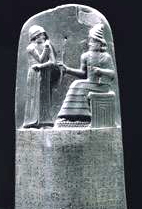|
Sumerian's (3500 and 2000 BCE): While writing emerged around 3200BCE, more than six centuries elapsed before the appearance of the earliest "historical," or more accurately "commemorative," inscriptions-dedicatory texts on bricks and door-hinge sockets, figurines buried in foundations, and votive inscriptions on vases, decorative plaques, mace heads, and the like.
It is a known fact that in the long stretch of time between approximately 3500 and 2000 B. C. it was the Sumerians who represented the dominant cultural group of the entire Near East. It was the Sumerians who developed and probably invented the cuneiform system of writing; who developed a well integrated pantheon together with spiritual and religious concepts which influenced profoundly all the peoples of the Near East.
and Epic of Gilgamesh - Wikipedia Another Sumerian Creation story is from the Eridu Genesis, 17 century BC.
The famous Enuma Elish, improperly called in modem times the "Babylonian Creation Epic." It is
in fact a hymn that glorifies Marduk by depicting
the acceptance of his leadership by the other gods. The Code of Hammurabi (1780 BCE):  Hammurabi was the ruler who chiefly established the greatness of Babylon, the world's first metropolis.
Hammurabi was the ruler who chiefly established the greatness of Babylon, the world's first metropolis.
The most remarkable of the Hammurabi records is his code of laws, the earliest-known example of a ruler proclaiming publicly to his people an entire body of laws, arranged in orderly groups. The Code of Hammurabi, was discovered by a French archaeological expedition under the direction of Jacques de Morgan in 1901-1902 at the ancient site of Susa in what is now Iran
The The Code of Hammurabi and the law of Moses. Similarities:
The Bible (1400 BC - 200 AD)  The front cover of The Oxford Companion To The Bible says,
The front cover of The Oxford Companion To The Bible says,"The Bible has had an immeasurable influence on Western culture, touching on virtually every aspect of our lives. It is one of the great wellsprings of Western religious, ethical, and philosophical traditions. It has been an endless source of inspiration to artists, from classic works such as Michaelangelo's Last Judgment, Handel's Messiah, or Milton's Paradise Lost, to modern works such as Thomas Mann's Joseph and His Brothers and many movies and TV series. For countless generations, it has been a comfort in suffering, a place to reflect on the mysteries of birth, death, and immortality. Its stories and characters are an integral part of the repertoire of every educated adult, forming an enduring bond that spans thousands of years and embraces a vast community of believers and nonbelievers."
The Bible is unique in that is considered the Word of God by most Jews and Christians. Egyptian Law (2000 BCE) The Precepts of Ptah-Hotep, c. 2200 BCE is a collection of maxims and advice in the sebayt genre on human relations, that are directed to his son. See: The Maxims of Ptahhotep - Wikipedia Greek Law (5th and 4th centuries BCE) Draco (621 BCE) and Solon (594) were two early Greek lawgivers. The code of Gortyn, which is itself the revised version of an older code, is the only one that comes close to being fully preserved. See Greek law -- Encyclopedia Britannica Chinese Law (2000 BCE) Chinese law has undergone continuous development since at least the 11th century BC. The earliest document on law in China that is generally regarded as authentic is the Kang Gao (康誥), a set of instructions issued by King Wu of Zhou to a younger prince for the government of a fief. The Canon of Laws or Classic of Law ( 法经) is a lost legal code that has been attributed to Lǐ Kuǐ (李悝), a Legalist scholar and minister who lived in the State of Wei during the Warring States Period of Chinese history (475-220 BCE)
See: Links: Ancient Myths Academy for Ancient Texts. Ancient texts library. Sumerian Mythology: Chapter I. The Scope and Significance of Sumerian Mythology Ancient History Sourcebook | fordham.edu Ancient written language The History of Ancient Mesopotamia: An Overview' , Dominique Charpin Enuma Elish - The Babylonian Epic of Creation (Article) -- Ancient History Encyclopedia Return to Religion
|